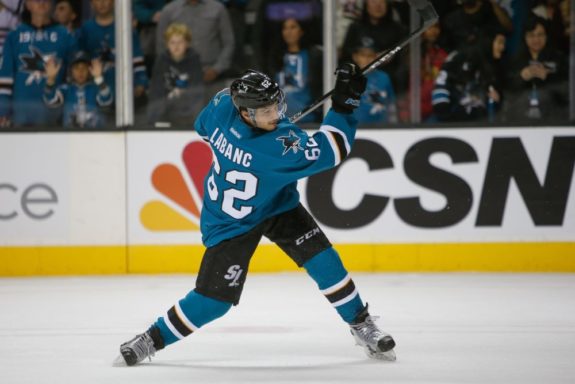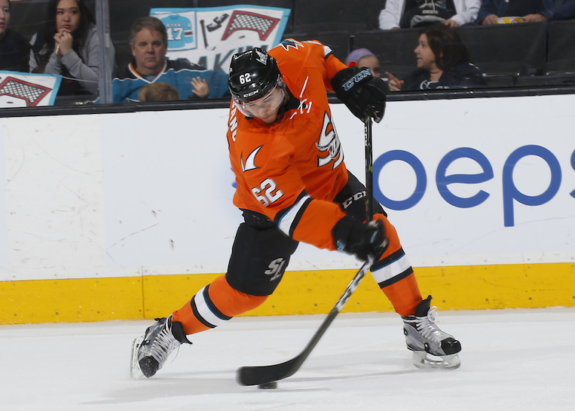The San Jose Sharks enter 2017-18 in a precarious position. After failing to come to terms with unrestricted free agent and franchise legend Patrick Marleau, the Sharks are poised to take a step back, at least offensively, without significant progress from the “five or six” rookies that general manager Doug Wilson expects to play on the team this season.
Welcome to the Sharks’ Party
Enter Kevin Labanc, a second-year pro who established himself as a mercurial figure last season, scoring 20 points in 55 regular season games amidst lofty expectations but in fits and starts. After scoring seven goals in 24 games through December, Labanc only managed one in the remaining 31 games, a drop off that may have had an effect on the coaching staff’s faith in him. Labanc suited up for none of the six playoff games in the Sharks’ first round series against the Edmonton Oilers.
Struggling to fill the ‘G’ column is a relatively new concern for the U.S. National Development Team alumnus. In Labanc’s final OHL season, he led the league in scoring with 127 points in 65 games for the Barrie Colts. What’s more, his 39 goals were good enough for thirteenth in the OHL.

It’s possible that playing with the Sharks’ AHL affiliate had an effect on his style. A point per game player through 19 contests with the Barracuda, Labanc recorded only six goals, preferring to pass to his linemate and triggerman Nikolay Goldobin.
As fate would have it, however, Goldobin was traded to the Vancouver Canucks along with a conditional fourth round pick for Jannik Hansen to shore up for the Sharks’ ill-fated Stanley Cup run. This influenced Labanc’s production in the Calder Cup playoffs, where he recorded three goals and seven points in 15 postseason games; not terrible, but a significant step back from his regular season pace.
The loss of Goldobin, an important factor when considering Labanc’s decline, did not affect his production in the NHL where he spent most of the season sharing a line with Joes Thornton and Pavelski. While his possession metrics improved dramatically with the Joes (53.51% on-ice Corsi For at even strength with Thornton, compared to 44.57% with Logan Couture), his most productive time in terms of goals came when sharing space with Couture and either Mikkel Boedker or Joonas Donskoi.

Variations in on-ice shooting percentage explain some of this discrepancy. For example, Labanc’s on-ice shooting percentage with Thornton was only 9.8 while with Couture it was 11.7, much closer to his individual shooting percentage of 11.4. Unfortunately, his personal shot numbers took a hit as well.
Before the New Year, Labanc put 37 shots on goal in 24 games or 1.54 shots per game. From January on, he managed to only average one shot per game for the season’s remaining 26 contests. It’s a significant drop off in shot production, and, when paired with the improvement in his share of on-ice shot attempts, it is concerning.
Labanc in Good Company
What does this mean going forward? We can draw some information from former scoring leaders of the OHL and what their second pro seasons looked like. The five OHL scoring leaders immediately preceding Labanc’s 2015-16 campaign from most recent are: Dylan Strome, Connor Brown, Vincent Trocheck, Michael Sgarbossa and Tyler Toffoli.
There are some household names in there, especially if the household is in Ontario, and while Sgarbossa has struggled to stick at the NHL level, recording 10 points in only 48 NHL games since the 2014-15 season, the other four are promising.
To be fair, Strome and Brown made names for themselves during their junior careers sharing a line with some chump named Connor McDavid, but Strome scored 111 points in 2015-16 after McDavid left, so it seems like Brown’s league-leading season is the only one we should be looking at askance.

Strome struggled to make an impression with the Arizona Coyotes, who sent the 2015 third overall pick back to the OHL’s Erie Otters, where he scored an impressive 75 points in 35 games. He is likely ready for a larger role in the NHL starting next season, where expectations are high.
Trocheck and Toffoli have already made their mark in the NHL, and their sophomore seasons were improvements, producing 53 and 49 points, respectively. If recent history is any indication, therefore, Labanc should be relevant on the scoreboard this season.
Play it Again, Sam… er, Kevin
There will be no shortage of opportunity for Labanc to impress. With team captain Pavelski locked into the top line right wing spot, any of the bottom three are up for grabs coming into camp, and Labanc will be competing with players like Joel Ward, Joonas Donskoi, Timo Meier, and others, regardless of the possibility that Labanc or any of his competitors switch wings. Labanc has a history of production and the experience at the NHL level to carve out a role for himself on the Sharks, if not in training camp, or later in the season.
It isn’t unreasonable to put our expectations in the realm of 40-45 points for Labanc. Let’s wait to cross our fingers for a breakout, though, until he shows some of that penchant for scoring goals again.